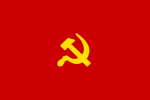Hukbalahap
| Hukbalahap | |
|---|---|
| Participant in Hukbalahap Rebellion | |

Flag of the Hukbalahap
(since 1950) |
|
| Active | 1940 – 1965 |
| Ideology | Communism |
| Leaders | Luis Taruc |
| Headquarters | Pampanga |
| Area of operations | Central Luzon |
| Became | New Peoples Army |
| Allies |
|
| Opponents |
|
The Hukbalahap (Filipino: Hukbong Bayan Laban sa mga Hapones, English: The Nation's Army Against the Japanese Soldiers), or Hukbong Laban sa Hapon (Anti-Japanese Army), was a Communist guerrilla movement formed by the peasant farmers of Central Luzon. They are popularly known simply as "Huks". They were originally formed to fight the Japanese, but extended their fight into a rebellion against the Philippine Government, known as the Hukbalahap Rebellion in 1946. It was finally put down through a series of reforms and military victories by Filipino President Ramon Magsaysay.
As originally constituted in 1942, the Hukbalahap was to be part of a broad united front resistance to the Japanese occupation of the Philippines. This original intent is reflected in its name: "Hukbong Bayan Laban sa mga Hapon", which means "People's Army Against the Japanese."
By 1950, the Communist Party of the Philippines PKP had resolved to reconstitute the organization as the armed wing of a revolutionary party, prompting a change in the official name to Hukbong Mapagpalaya ng Bayan, (HMB) or "Peoples' Liberation Army," likely in emulation of the Chinese People's Liberation Army.
Notwithstanding this name change, the HMB continued to be popularly known as the Hukbalahap, and the English-speaking press continued to refer to it and its members, interchangeably, as "The Huks" during the whole period between 1945 and 1952.
The Hukbalahap movement has deep roots in the Spanish encomienda, a system of grants to reward soldiers who had conquered New Spain, established about 1570. This developed into a system of exploitation. In the 19th century, Filipino landlordism, under the Spanish colonization, arose and, with it, further abuses. After the opening of ports in Manila, the Luzon economy was transformed to meet the demands for exports of rice, sugar, and tobacco. Landowners increased demands on farmers, who rented parcels of land. These demands included increased rents, demands for proceeds from the sale of crops, and predatory lending agreements to fund farm improvements. Only after the coming of the Americans were reforms initiated to lessen tensions between tenants and landlords. The reforms, however, did not solve the problems and, with growing political consciousness produced by education, peasants began to unite under educated but poor leaders. The most potent of these organizations was the Hukbalahap, which began as a resistance organization against the Japanese but ended as an anti-government resistance movement.
...
Wikipedia
